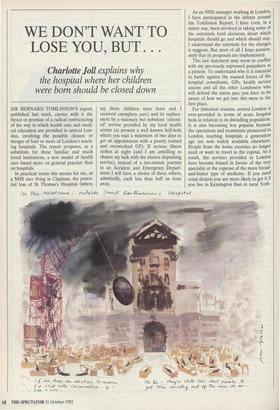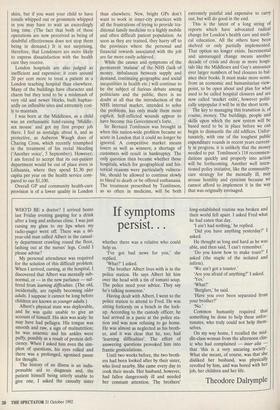WE DON'T WANT TO LOSE YOU, BUT . . .
Charlotte Joll explains why
the hospital where her children were born should be closed down
SIR BERNARD TOMLINSON'S report, published last week, carries with it the threat or promise of a radical restructuring of the way in which health care and medi- cal education are provided in central Lon- don, involving the possible closure or merger of four or more of London's teach- ing hospitals. The report proposes, as a substitute for these familiar and much loved institutions, a new model of health care based more on general practice than on hospitals.
In practical terms this means for me, as a NHS user living in Clapham, the poten- tial loss of St Thomas's Hospital (where my three children were born and I received exemplary care) and its replace- ment by a visionary but nebulous 'extend- ed' service provided by my local health centre (at present a well known hell-hole where you wait a minimum of two days to get an appointment with a poorly trained and overworked GP). If serious illness strikes at night (and I am unwilling to chance my luck with the elusive deputising service), instead of a ten-minute journey to an Accident and Emergency Depart- ment I will have a choice of three others, admittedly, each less than half an hour away.
As an NHS manager working in London, I have participated in the debate around the Tomlinson Report. I have even, in a minor way, been involved in taking some of the extremely hard decisions about which hospitals should go and which should stay. I understand the rationale for the changes it suggests. But most of all I hope passion- ately that its proposals are implemented.
This last statement may seem to conflict with my previously expressed prejudices as a patient. To understand why it is essential to battle against the massed forces of the hospital consultants, GPs, health service unions and all the other Londoners who will defend the status quo, you have to be aware of how we got into this mess in the first place. For historical reasons, central London is over-provided in terms of acute hospital beds in relation to its dwindling population. It is also becoming less popular because the operations and treatments pioneered in London teaching hospitals a generation ago are now widely available elsewhere. People from the home counties no longer need or want to travel to the capital. As a result, the services provided in London have become biased in favour of the very specialist at the expense of the more bread- and-butter type of medicine. If you need renal dialysis you are more likely to get it if you live in Kensington than in rural York- shire, but if you want your child to have tonsils whipped out or grommets whipped in you may have to wait an exceedingly long time. (The fact that both of these operations are now perceived as being of doubtful effectiveness does not stop them being in demand.) It is not surprising, therefore, that Londoners are more likely to express dissatisfaction with the health care they receive.
London hospitals are also judged as inefficient and expensive: it costs around 20 per cent more to treat a patient in a London teaching hospital than elsewhere. Many of the buildings have character and charm but they tend to be a mishmash of very old and newer blocks, built haphaz- ardly on inflexible sites and extremely cost- ly to maintain.
I was born at the Middlesex, as a child was an enthusiastic fund-raising 'Middle- sex mouse' and got my first proper job there. I feel as nostalgic about it, and as protective, as Auberon Waugh does of Charing Cross, which recently triumphed in the treatment of his rectal bleeding (Another voice', 5 September). However, I am forced to accept that its out-patient department would be out of place even in Lithuania, where they spend $1.30 per capita per year on the health service com- pared to our $1,100.
Overall GP and community health-care provision is of a lower quality in London than elsewhere. New, bright GPs don't want to work in inner-city practices with all the frustrations of trying to provide tra- ditional family medicine to a highly mobile and often difficult patient population. As soon as they are trained, they hurry off to the provinces where the personal and financial rewards associated with the job are far more easily achieved.
While the causes and symptoms of the permanent `malaise' of the NHS (lack of money, imbalances between supply and demand, continuing geographic and social inequalities in health etc.) will continue to be the subject of furious debate among politicians and the public, there is no doubt at all that the introduction of the NHS internal market, intended to solve the problems, has only made them more explicit. Self-inflicted wounds appear to have become this Government's forte.
Sir Bernard Tomlinson was brought in when this nation-wide problem became so acute in London that it could no longer be ignored. A competitive market means losers as well as winners; a shortage of customers will result in bankruptcy. The only question then became whether those hospitals, which for geographical and his- torical reasons were particularly vulnera- ble, should be allowed to continue slowly to bleed. to death or be offered euthanasia. The treatment prescribed by Tomlinson, as so often in medicine, will be both extremely painful and expensive to carry out, but will do good in the end. This is the latest of a long string of reports which have advocated radical change for London's health care and medi- cal education. All the others have been shelved or only partially implemented. That option no longer exists. Incremental and unmanaged change means another decade of crisis and decay as more hospi- tals like the Middlesex and Guy's announce ever larger numbers of bed closures to bal- ance their books. It must make more sense, from an economic and humanitarian view- point, to be open about and plan for what used to be called hospital closures and are now called `market exits', however politi- cally unpopular it will be in the short term. The key to managing this transition is, of course, money. The buildings, people and skills upon which the new system will be based need to be in place before we can begin to dismantle the old edifices. Unfor- tunately, with one of the toughest public expenditure rounds in recent years current- ly in progress, it is unlikely that the money needed to put Tomlinson's 118 recommen- dations quickly and properly into action will be forthcoming. Another well inten- tioned policy initiative, like the community- care strategy for the mentally ill, may arouse hostility and cynicism because we cannot afford to implement it in the way that was originally envisaged.



























































 Previous page
Previous page